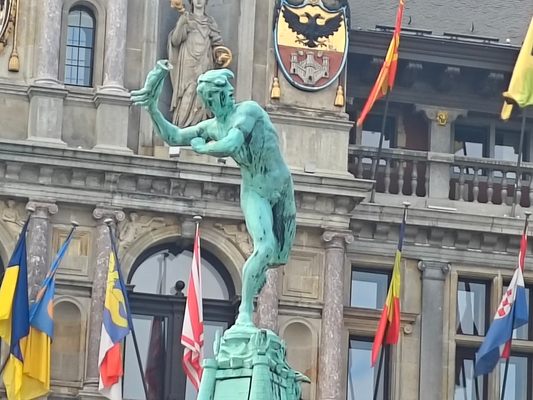
The History of Belgium’s Hand-Shaped Chocolates
Share
Hello Everyone,
Thank you for sharing my interest in the history of Belgium's severed hands. urprisingly, I had never heard of this until today. am stunned that people would want to indulge in hand-shaped chocolates anyway.But to each their own, right?
Antwerp, Belgium is the capital of chocolate, selling it in various shapes and flavors, ranging from little peeing boys (manneken pis) to more traditional shapes such as animals and happy faces. But one of the most popular shapes is a severed hand.
Brabo Fountain. John Paul Antes/cc by-sa 4.0
The Legend Behind the Hand
The legend of Antwerpse handjes (Antwerp hands) tells of a giant named Druon Antigoon who terrorized people near the Scheldt River, demanding tolls and severing the hands of those who couldn't pay. A brave soldier named Silvius Brabo eventually defeated the giant, cutting off his hand and throwing it into the river. This act is believed to have inspired the name "Antwerp," derived from the Dutch words hand werpen, meaning "hand throwing." Over time, severed hands became a symbol of the city, first as cookies decorated with sliced almonds, and later as chocolates filled with praline or marzipan. Today, these hand-shaped treats are a popular delicacy in Antwerp.
 Congolese men hold the severed hands of their compatriots, Bolenge and Lingomo, alongside British missionaries (1904).
Congolese men hold the severed hands of their compatriots, Bolenge and Lingomo, alongside British missionaries (1904).
The History Prior to Hand-Shaped Chocolates
While the myth seems like a sweet victory, there is a off putting history of the Congolese people with the same symbolism. King Leopold II of Belgium ruled over the Congo Free State from 1885 to 1908 in what became one of history’s most brutal colonial regimes, resulting in over 10 million people in the Congo dying, according to standard historical data. Under his control, the Congo was not a Belgian colony but his personal property, exploited for its vast natural resources—particularly rubber.
To maximize profits, Leopold’s regime imposed a harsh system of forced labor. Congolese villagers were forced to meet rubber quotas under the threat of extreme punishment. One of the most infamous atrocities was the practice of cutting off hands. Soldiers from the Force Publique, Leopold’s private colonial army, were required to account for every bullet they fired. To prove bullets weren’t wasted on hunting or rebellion, they were ordered to present severed hands as evidence of their killings. In many cases, hands were cut off from the living as a form of punishment or intimidation.
Millions of Congolese lives were lost due to execution, forced labor, disease, and starvation. Reports from missionaries, journalists, and former officials exposed these atrocities to the world, sparking an international human rights movement. In 1908, under global pressure, Belgium’s government took control of the Congo, ending Leopold’s personal rule. However, the exploitation and suffering of the Congolese people continued under Belgian colonial rule until independence in 1960.
The Controversy of the Hand-shaped chocolates
This now traditional practice in the Belgian chocolate industry did not exist until after this torturous practice took place in Congo. Anthropologists have studied and established this fact.
So as visitors purchase souvenirs depicting severed hands, the symbolism is connected to Antigoon and Brabo, never to the atrocities perpetrated in the Congo. Tourists in Antwerp are redirected repeadetly to the Brabo narrative; the city has no memorials dedicated to the Congolese murdered during colonial rule.The severed hand symbolizes the triumph of the Flemish spirit over a maniacal giant. It is also a sinister reminder of the brutality enacted upon Central Africans during Belgian colonial rule.
Leopold II’s legacy also remains deeply controversial. While he funded grand architecture in Belgium, the wealth that fueled his projects came at an unimaginable human cost. Today, his role in the Congo is widely condemned, with growing calls to remove statues honoring him and to acknowledge the horrors of his reign.
Here are more resources:

